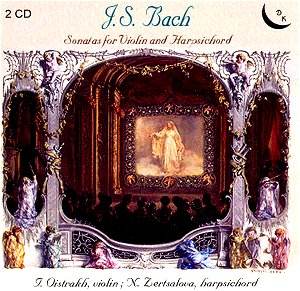Sonata No.1 for violin and harpsichord in B minor BVW 1014
Sonata No.2 for violin and harpsichord in A major BVW 1015
Sonata No.3 for violin and harpsichord in E major BVW 1016
Sonata No.4 for violin and harpsichord in C minor BVW 1017
Sonata No.5 for violin and harpsichord in F minor BVW 1018
Sonata No.6 for violin and harpsichord in G minor BVW 1019
CDK Music present a recording of the J.S. Bach
six sonatas for violin and harpsichord played by husband and wife
team Igor Oistrakh and Natalia Zertsalova. The rather cheap looking
and meagre booklet notes provide no details of the performance
venue or recording date.
The six sonatas for violin and harpsichord BWV
1014-1019 were not published until over fifty years after Bach’s
death. Perhaps the reticence on behalf of his publisher was due
to the considerable technical demands required of the soloists.
The sonatas are remarkable as Bach does not use the customary
basso continuo accompaniment, writing a complete harpsichord
part which shares the melody on an equal basis. I find the sonatas
to be fine examples of Bach’s remarkable polyphonic writing as
superbly demonstrated by the third movement Andante of
the second sonata in A major BWV 1015. Another major feature is
Bach’s slow movements where he most often scaled new heights,
demonstrating a state of sublimity never previously achieved by
others.
Steeped in musical tradition and a violinist
of the ‘old school’, there are few technical difficulties that
Igor Oistrakh cannot brush aside. His playing for the most part
is uncomplicated without a hint of risk-taking or noticeable idiosyncrasy.
Oistrakh displays a natural elegance and an intelligent musicianship
yet I was left wishing that I had experienced more expressive
warmth, increased lyricism and improved poetry. The partnership
is not as effective and satisfying team-wise as one might expect.
The playing of Natalia Zertsalova on harpsichord is wonderfully
articulate but does not manage sufficient presence and seemed
overawed by Oistrakh’s presence.
When checking the catalogue I was amazed by the
number of alternative versions of these works and the listener
is spoiled for choice. My particular favourite is the evergreen
recording by Arthur Grumiaux and Christiane Jaccottet digitally
remastered on Philips Classics Duo 454 011-2. This very special
recording of the sonatas BWV 1014-1019 was made in 1978, still
sounds excellent, and always manages to raise the hairs on my
neck. Of the more recent recordings I also rate exceptionally
highly the stylish and colourful digital interpretation on period
instruments from Giuliano Carmignola and Andrea Marcon on Sony
Classical S2K 89469. Another contemporary alternative is the digital
recording from Rachel Podger and Trevor Pinnock using period instruments,
on Channel Classics 14798 CD. This is marvellous in both sound
and performance and is the first choice of many shrewd judges.
This recording although finely played is not
the one that I would choose in this repertoire as the competition
is far too tough for Oistrakh and Zertsalova.
Michael Cookson
